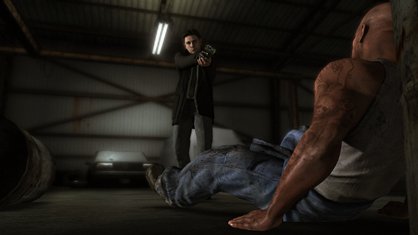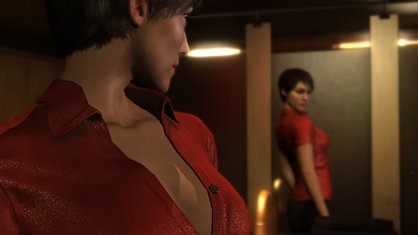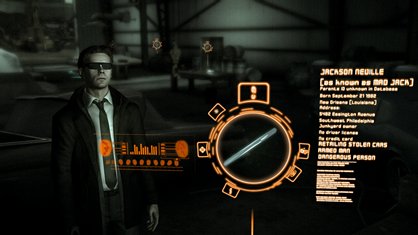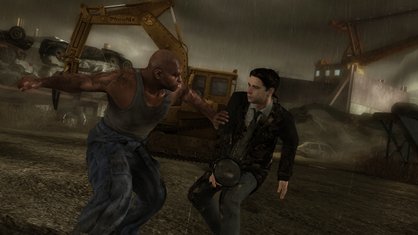Heavy Rain: the David Cage interview
Auteur talks permanent death, emotional buildup and what went wrong with Indigo Prophecy

Above: David Cage, center, with Quantic Dream co-CEO Guillaume de Fondaumiere
Cage is a proven auteur, having also helmed the critically acclaimed Indigo Prophecy (Fahrenheit in Europe) and Omikron: The Nomad Soul, and both he and Sony have been tight-lipped on a lot of the details surrounding Heavy Rain (which was recently confirmed for release early next year). In order to claw our way closer to the heart of the mystery, we caught up with Cage via email to glean a few new insights into the project.
GamesRadar: Now that it’s been more than a month since Heavy Rain was shown at E3, what kind of feedback have you received on the game since then? Do people seem to understand and appreciate what you’re trying to create, or do you feel that there are still some misconceptions?
David Cage: When you try to create something different, there is always a mix of enthusiasm and skepticism, and I think this is fair. Many designers claimed they have invented something revolutionary in the past, and if it was true for some of them, it was sometimes also a source of disappointment.
With Heavy Rain, we’re creating something that changes many traditional game paradigms. We try to invent something that is almost not a video game in the traditional sense (adrenaline, obstacles, levels, die-and-retry), but something that is closer to an emotional journey. When you pretend this, people may think that it won’t be interactive or exciting, because no one has tried this direction before, so there is no point of reference.

I spend a lot of time going against preconceived ideas, saying that a story could be told through gameplay and not through cut scenes, that more complex emotions can be triggered in an interactive experience, and that yes, video games can be more than just toys for teenagers. Believe me; it is not always easy, because preconceived ideas are difficult to change. Videogames are based on the same concepts for twenty years. I believe (and it seems I’m not the only one anymore) that time has come for a change.
I don’t pretend that Heavy Rain will be a revolution and I don’t know if people will love it or hate it. All I can say is that it is definitely going to be different.
GR: The news of the game’s delay until 2010 came as a shock to some, given that a lot of people seemed to be under the impression that Heavy Rain’s trailers had promised a 2009 release date. Can you talk a little about why the game was pushed back?
Sign up to the GamesRadar+ Newsletter
Weekly digests, tales from the communities you love, and more
DC: Heavy Rain was never announced for 2009, however, recently at E3 we did talk about the game becoming available in early 2010.
GR: Part of the title’s meaning – The Origami Killer – has been made clear, but does Heavy Rain refer to anything specifically in the game? Is it foreshadowing something, like Fahrenheit and its ice-age doomsday scenario?
DC: Rain plays a very important role in the story. It constitutes the background of most scenes, but it is also an important part of the drama. We used rain like a character, trying to characterize it and give it moods supporting the ambiance and the narrative.

GR: Heavy Rain’s control scheme – in which you move your character’s head to direct him or her in a specific direction – is unusual. What inspired that decision?
DC: My obsession is to detach controls and the camera, make them as independent as possible. Most games use a chase cam, which is very convenient for controls but was not satisfying for an experience trying to use the camera to tell the story.
Changing the control scheme was the most obvious thing to do to free the camera. Moving forward like in a racing game and controlling the head of your character quickly became quite a logical decision.
I know it is always difficult to change conventions, but I got the feeling that with controls and other things, we have gone as far as possible with the current conventions. If you want to go further, you have to break something and start again from scratch with new ideas. I am excited by this possibility to try new options and investigate new ideas.

GR: While we’re on the subject of control, are all of the action sequences in Heavy Rain going to be Quick Time-style, with timed button presses? About what percentage of the game do you think will be spent exploring, versus participating in the more tense action bits?
DC: Heavy Rain is a game of exploration, interaction with the environment and decision-making. It also features some spectacular action sequences using a different control scheme that I would not exactly describe as Quick Time Events. I need to explain a little bit what I mean by that.
Many games fall into categories of “shooter” or “fighting game.” Some games feature both styles with some limitations. What does this mean, exactly? In short, it means player actions will be limited to a certain type of action scene, that he will play through different levels using repetitive mechanics and a limited set of animations. I think this genre is great for a certain audience, but it was definitely not the type of game we wanted to create. It is also very difficult to tell a story with repetitive action sequences. We believe the audience that will be drawn to Heavy Rain will want something different.
So we made the decision to have a more generic type of interface, inspired by the QTE system used by Yu Suzuki in Shenmue, but trying to make them evolve to make them a truly immersive control scheme.

We have done many things to make the sequences very enjoyable moments: we created very spectacular action scenes, each one being unique, and featuring unique movements instead of generic animation banks. We integrated controls in 3D and animated them with their target. We also entirely changed the pacing of these sequences: it is the player makes every single move of the character, he is really at the heart of the action, with very spectacular animations, a real sense of directing, and a strong sense of immersion. The player will immediately see the result of his action, failure or success, with a specific sequence. Last but not least, we fully use the controller, including sticks and Sixaxis, which provides a very intense experience.
We are very pleased with the feedback these scenes received so far. Even hardcore gamers told us they really felt they were really immersed in the action. I think players will be surprised by some action sequences in the game, how diverse, immersive and, of course, interactive they are.



